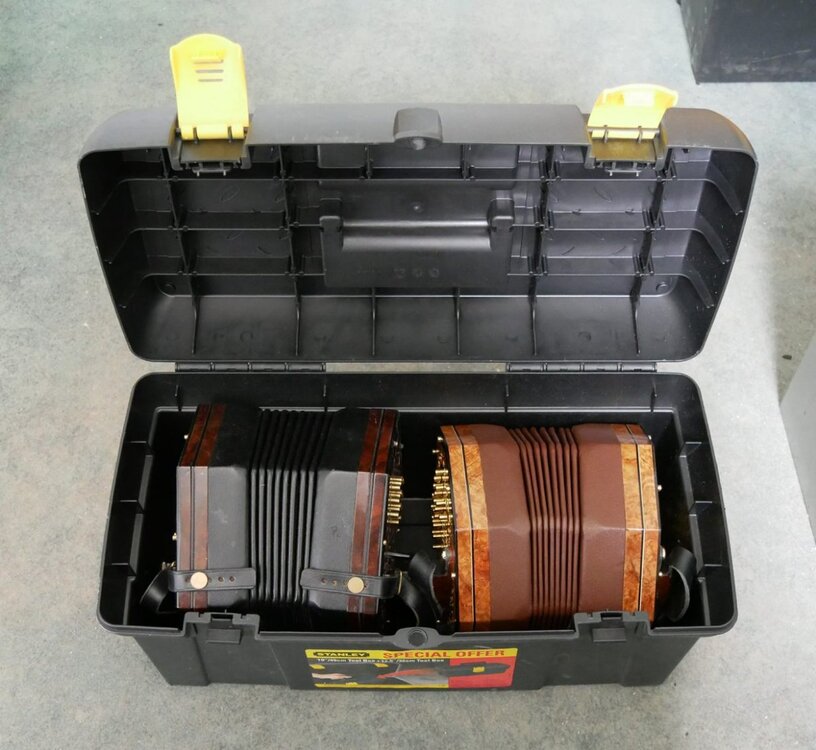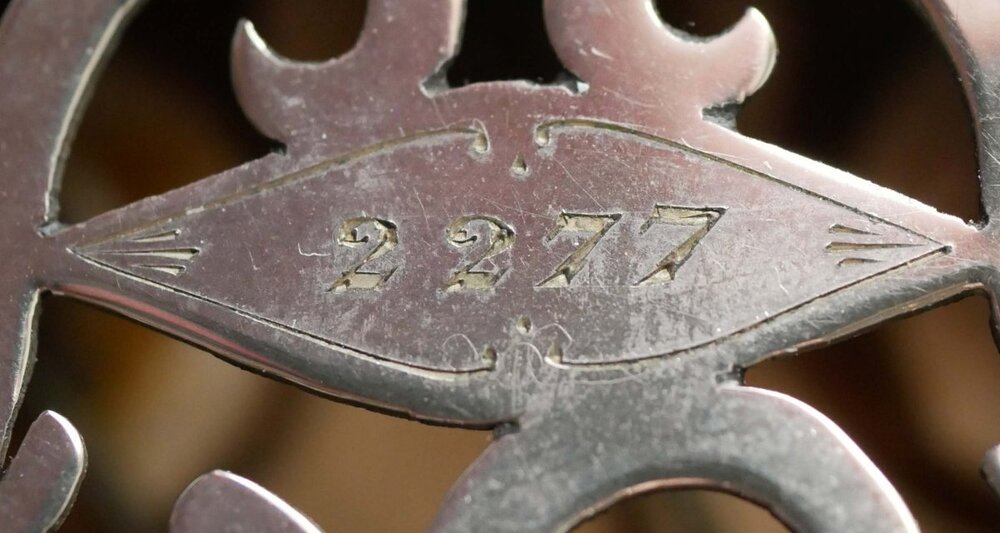
Richard Mellish
Members-
Posts
465 -
Joined
-
Last visited
Everything posted by Richard Mellish
-
Double Case Recommendations
Richard Mellish replied to cohen's topic in General Concertina Discussion
Is this it? https://www.sainsburys.co.uk/gol-ui/Product/curated-living-gardening-box Can you say any more about it? Dimensions? Weight? The handles might need padding if you're going to be carrying it very far. -
Digital concertina
Richard Mellish replied to Gregor Markič's topic in Instrument Construction & Repair
I decided to avoid real bellows both for simplicity and because it avoids the problem of running out of air. (That is manageable on a real concertina, of course, but my idea is to have no limit on the length of time in one direction.) I have found some push-button switches that are small enough but I don't yet know how satisfactory they will be. If and when I actually finish the project I will report here on how well or otherwise my ideas have worked. -
I'm assuming you're not a concertina player yourself. I apologise if the following is grandmother egg-sucking. It wouldn't hurt to check which are its basic keys. Press the one button that's away from all the others, nearer the hand rest on one end, and pull the bellows out a bit, then release that button, press a few of those in the middle row on either end and push the bellows together. You should get a chord. If it's C major the instrument's two basic keys are C and G, which is the commonest combination and most popular in Ireland. A major influence on its value is its condition. For a start, do all the notes work (each button in both directions of the bellows)? Do they all sound OK? If you push and pull gently on the bellows, without pressing any buttons, does much air leak in (when you're pulling) or out (when you're pushing)?
-
Digital concertina
Richard Mellish replied to Gregor Markič's topic in Instrument Construction & Repair
Whether it's a no brainer depends on your brain. I did a very little machine code (and I mean machine code, not assembly language) many years ago and I'm a regular user of BBC BASIC, but I would not know how to get an Arduino or any such device to generate either MIDI instructions or sounds directly. I'm currently working on a project with a dedicated interface board http://www.doepfer.de/ctm.htm That can be fed directly by push switches if it's one note per switch, but to reproduce the fingering of an Anglo with two different notes according to whether you're pulling or pushing it needs a board full of relays, which I am now part way through wiring up. I have constructed a rudimentary pair of handles connected to a strain gauge and a bit of electronics to generate the push/pull signal and an analogue voltage proportional to pressure (push or pull) to control the volume. -
I'm struggling with that. It implies removing bellows pressure after every note before you play the next note. There isn't time for that, least of all with Irish music if it's going at 90 mph as it often does. Am I misunderstanding?
-
I have always found that even one key away from the two basic keys on an Anglo (e.g. D or F on a C-G box) is a lot harder than the basic keys. I can work out out to play a tune but it is much less instinctive. So for me the benefit of more buttons is not multiple keys but occasional accidentals and the choice of directions for the same notes. With the first instrument that was made for me, the maker pointed out that it is better to have more buttons and not use all of them than to have a certain number and wish you had more. On that basis he suggested giving me 40. The only real downside of that has been that I use some of the extras buttons a lot, so that as I have acquired more concertinas I have always wanted the same (or very similar) 40-key layout, and those are thinner on the ground and more expensive. If playing in more than a very few keys is important, a Hayden Duet might be more appropriate.
-
Up to the age of about 20 I started and gave up the piano several times and dabbled with several other instruments, never getting very far. Soon after I got into folk song I decided that there were already too many mediocre guitar players about and that I had no wish to add to their number. One day, when I was living in a university hall of residence, I found a concertina in a store room, twiddled for a bit and found I could make sense of it. I found out who it belonged to and he offered it to me for the £2 that it had cost him. It was a cheap and cheerful East German 20-button one but it got me started. Then a chap I knew through the university folk club had (I think) recently upgraded and offered me his old one, which was a 30 key Lachenal, for nothing. It was in poor shape, having had leaks plugged with toilet paper, but I made it a bit better and it served me for a while.
-
Dating A Lachenal From The Serial Number
Richard Mellish replied to johnconstable's topic in Concertina History
I don't disagree. I only asked. -
Dating A Lachenal From The Serial Number
Richard Mellish replied to johnconstable's topic in Concertina History
While that is probably true, how important is it relative to playability by its current owner? -
Anglo Cross Row and In Row Harmony Style
Richard Mellish replied to Kelteglow's topic in Teaching and Learning
I think you're onto something there. For some of the time I leave my left hand to do its own thing, with minimal input from my conscious mind, but what the hand does is of course heavily influenced by the instrument. -
One of my favourite quotations is from Terry Pratchett: "Inside every old person is a young person wondering what happened".
-
Anglo Cross Row and In Row Harmony Style
Richard Mellish replied to Kelteglow's topic in Teaching and Learning
I go along with all that and would add one other virtue of the Anglo: that in each of its basic keys you have sixteen notes available without moving your fingers from a home position (four fingers on four buttons on each end). Of course there is more, but when in doubt there is always that home position. -
Some more questions now arise How on earth were all those extra reeds squeezed in? Can you post some pictures? And ---- what do you plan to do with it now?
-
Double Case Recommendations
Richard Mellish replied to cohen's topic in General Concertina Discussion
That is fair comment but the (single) cases that came with two of my concertinas don't have blocking. I will not name the manufacturers, nor say whether the instruments are vintage or modern, but the cases are those that were supplied by the makers. -
Double Case Recommendations
Richard Mellish replied to cohen's topic in General Concertina Discussion
I have been wondering for some time about possible cases for multiple concertinas. While reading this thread I suddenly thought that a spare Stanley toolbox might be suitable, so I have just tried it for size. These are the largest two of my Anglos and they do just fit, with some space left for padding, though only a little. -
Do you mean that you don't know which note is signified by each line and space on the stave? If that's your problem, see https://en.wikipedia.org/wiki/Clef . When I was a small child my grandfather taught me the mnemonic for the five lines of the treble clef: Every Good Boy Deserves Fruit.
-
Assuming that you have a smartphone, how about installing a tuning app? They are primarily intended for telling you whether a note is sharp or flat of its correct pitch when you are tuning an instrument such as a guitar, but they also tell you what the note is. One example is https://play.google.com/store/apps/details?id=ru.aterlux.guitartuner
-
This concertina reached me yesterday. It deserves tuning and a general overhaul in due course but it is in good condition and perfectly playable to be going on with. Donovan absorbed the shipping cost so I have made the donation to concertina.net. The Wheatstone ledgers tell me that it was made in 1965, so it's a late one, not quite of the quality from the golden age, but it's still a decent box. I may bring it when I next come to a real TSF meeting, if I travel by car. If it's in Sheffield (for example) I'm more likely to travel by train and I'm not keen on taking concertinas on public transport after twice absent-mindedly leaving one on the Underground. (Though I was lucky and got them back.)
-
OK, that makes sense, thank you. Well, a kind of sense, if they deemed this one to be a kind of Duet, which just happens to have mostly different notes on push and pull. About when would they have allocated that number? I don't think I would ever get used to it, when I have been playing 40-key Wheatstone layout Anglos for nearly 40 years. I bid high enough to get it because I was curious about it and reluctant to let to go to someone unknown, where it might never be heard of again. I will get it overhauled anyway, then when it's back in good condition I will offer it here for anyone who feels like tackling its idiosyncrasies. If no-one offers close enough to what it will have cost me I will keep it, and probably twiddle occasionally, until either I need to sell it for whatever it will fetch, to help to support me in my dotage, or I die. I have specified to my executors what to do with all my concertinas when I die.
-
Regarding it as some (very distant, bastard) relative of a McCann might explain the McCann patent number on the straps.
-
I mentioned the action plates being stamped "2277". The same number is also on the left-hand end, where one would expect a serial number. But 2277 would be a pretty early number for a Lachenal, and this instrument is surely not that early. Anyone have any idea when it might have been made and what the number 2277 signifies?
-
VAT and Import Duty.
Richard Mellish replied to Geoff Wooff's topic in General Concertina Discussion
I've just had a phone call from DHL, wanting to know what the item is that is coming to me. I said "A concertina" and they said "What's that?", so I told them it's a musical instrument. They told me that it counts as "new goods" coming into the UK, and therefore subject to import charges, even though it was made here, because that was more than three years ago. That makes little sense, but "the law is an ass" as they say, and I knew I might have to pay so I'm not greatly bothered. They're not asking for payment now but said I will either get a message some time before it's delivered or get an invoice in the post. -
Wheatstone vs Jeffries Layout; A5 or A6
Richard Mellish replied to alex_holden's topic in General Concertina Discussion
How do you reckon a G#? I would expect everything on a Bb/F to be two semitones down from the corresponding notes on a C/G, so the G in that position is as expected.




